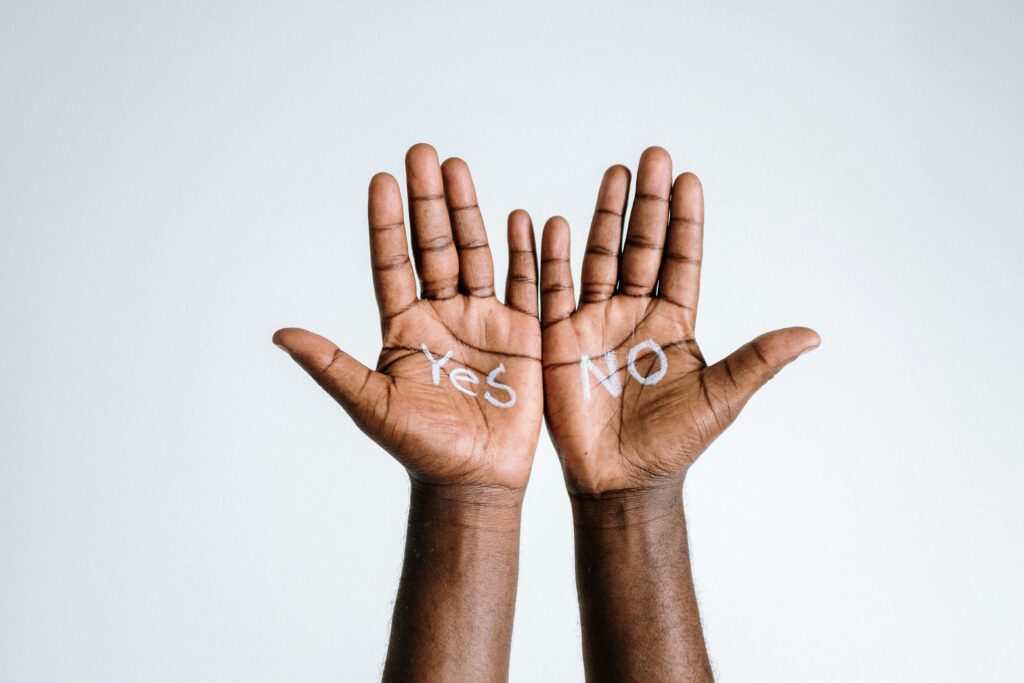🧭 Introduction: Why Saying No Matters
Power of Saying No: Have you ever said “yes” when you really wanted to say “no”? Maybe it was to avoid conflict, guilt, or disappointing someone. You’re not alone. Most of us have been there. But what if I told you that saying “No” is one of the most powerful things you can do for your mental health, productivity, and relationships?
Saying no isn’t about being rude or selfish—it’s about self-respect and living intentionally. When you set clear boundaries, you’re not just protecting your time and energy; you’re building a life that aligns with your values. In this article, we’ll explore how saying no can transform your life, the psychology behind it, and actionable strategies to make it easier.
Let’s dive into the power of saying no.
1. The Psychological Impact of Always Saying Yes
Saying yes all the time may feel like the right thing to do, but it can come at a hefty price. Whether it’s taking on extra work, agreeing to social events you don’t enjoy, or stretching yourself thin for others, chronic “yes-syndrome” is exhausting.
People-Pleasing: A Deeply Ingrained Habit
People-pleasers often grow up in environments where approval is tied to obedience. Over time, saying yes becomes a survival mechanism. It’s not just about being nice—it’s about avoiding rejection or conflict.
But constantly accommodating others leaves little room for your own needs, dreams, and growth.
The Emotional Toll of Overcommitment
When your calendar is full of commitments you didn’t truly want, resentment builds. Stress, burnout, and even depression can set in. You start feeling trapped in a life that doesn’t feel like yours.
By learning to say no, you start reclaiming your autonomy, and with it, your peace of mind.

2. Understanding Boundaries: What They Really Mean
Boundaries aren’t walls; they’re gates. They let the right things in and keep the harmful things out. And yet, many people don’t even realize they have the right to set them.
Types of Personal Boundaries
- Physical boundaries – Your space and touch preferences.
- Emotional boundaries – What feelings you are responsible for (and not).
- Time boundaries – How you spend your hours.
- Mental boundaries – Your opinions, thoughts, and values.
- Material boundaries – What possessions you share and with whom.
Healthy vs. Unhealthy Boundaries
| Type | Healthy Boundary | Unhealthy Boundary |
|---|---|---|
| Time | Saying no to overtime when you’re exhausted | Always agreeing to extra tasks |
| Emotional | Not taking responsibility for others’ feelings | Absorbing everyone else’s emotions |
| Physical | Declining hugs from acquaintances | Feeling obligated to accept physical contact |
Setting healthy boundaries leads to emotional freedom and stronger relationships.
3. The Benefits of Saying No
Mastering the art of saying no can completely transform your life. Here’s how:
Increased Self-Respect and Confidence
Every time you say no to something that doesn’t serve you, you say yes to self-worth. This builds confidence and sends a powerful message to yourself and others: “My needs matter.”
More Time and Energy for What Matters
Time is your most valuable resource. When you stop spreading yourself thin, you can finally focus on what truly matters—your health, your passions, your family.
Healthier Relationships
Ironically, setting boundaries actually improves relationships. People learn to respect you more, and interactions become more genuine. You stop being a doormat and start being a partner.

4. Why We Struggle to Say No
If saying no is so beneficial, why is it so hard? The answer lies in deep-rooted beliefs and emotional fears.
Guilt and Fear of Rejection
We often worry that saying no will make us seem selfish, lazy, or unkind. The truth? Saying no is a form of honesty—and real connections thrive on truth, not appeasement.
Cultural and Familial Conditioning
In many cultures, self-sacrifice is glorified. Saying yes is equated with being a “good person.” But there’s nothing noble about burnout. You can’t pour from an empty cup.
5. How to Say No Gracefully
Saying no doesn’t have to mean confrontation. There are diplomatic and respectful ways to do it.
The “Sandwich” Technique
This method wraps the no between two positives:
“I really appreciate you thinking of me. Unfortunately, I can’t take this on right now. I hope it goes well!”
Practicing Assertive Communication
Assertiveness isn’t aggression. It’s calm, clear, and confident. Use “I” statements, keep your tone neutral, and don’t over-explain.
6. Building Boundaries in Different Areas of Life
Each area of your life demands its own set of boundaries. Let’s explore how to apply them effectively.
At Work
- Decline extra tasks that aren’t part of your role.
- Set clear working hours.
- Don’t answer work emails during personal time.
In Family and Relationships
- Communicate emotional limits with loved ones.
- Don’t tolerate guilt-tripping or manipulation.
- Make space for your needs too.
With Friends and Social Circles
- Skip social events that drain you.
- Choose connections that energize and support you.
- Say no to peer pressure, even subtly.

7. Real-Life Examples of Transformational Change
Sometimes, the best lessons come from lived experience.
From Burnout to Balance
Samantha, a nurse, was constantly overworking. After nearly collapsing from stress, she started saying no to double shifts and yes to self-care. Within months, her energy returned, and her passion for her work was reignited.
Saying No to Toxic Relationships
Mark always said yes to his friend’s demands—rides, favors, money. He felt used. Once he began setting limits, that friend drifted away—and Mark gained peace.
FAQs: Mastering the Art of Saying No
1. Is saying no selfish?
Not at all. Saying no is a form of self-respect. It’s essential for your mental health and well-being.
2. How can I say no without feeling guilty?
Practice. Use gentle but firm language. Remind yourself that you have a right to your time and energy.
3. What if someone gets angry when I say no?
That’s about their expectations—not your worth. Stand your ground respectfully.
4. How do I build confidence in saying no?
Start small. Say no in low-stakes situations. Gradually build up as you gain comfort.
5. Can saying no ruin relationships?
Not if they’re healthy. Real relationships respect boundaries. If someone can’t handle a no, it might be time to reevaluate the connection.
6. Are there books or resources that help with boundary-setting?
Yes! A highly recommended read is Boundaries by Dr. Henry Cloud and Dr. John Townsend, a practical guide to setting healthy boundaries in every area of life.
🎯 Conclusion: Taking Back Control Through Boundaries
Saying no isn’t a rejection of others—it’s an affirmation of yourself. When you stop sacrificing your peace for the comfort of others, you start living a life that feels true and fulfilling.
Setting boundaries is one of the most loving things you can do—for yourself and the people around you. It shows you value your time, your health, and your happiness. So the next time you feel pressure to say yes, pause and ask yourself: “Does this serve me?” If not, give yourself permission to say no.
Your life is yours to design. Start building the boundaries that protect and empower it.
Explore More Articles to Empower Your Life
If you found value in learning how to say no and set boundaries, you’ll love these related articles designed to help you grow and take control of your life:
- The Complete Guide to Creating an Effective Morning Workout Routine
- The Importance of Hydration for Overall Well-being
- What to Eat Before and After Exercise
Check them out to continue your journey toward personal growth and empowerment!

